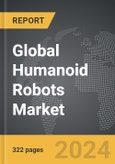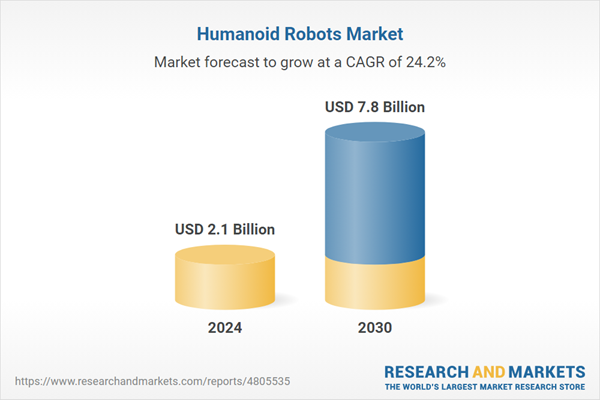The global market for Humanoid Robots was valued at US$2.1 Billion in 2024 and is projected to reach US$7.8 Billion by 2030, growing at a CAGR of 24.2% from 2024 to 2030. This comprehensive report provides an in-depth analysis of market trends, drivers, and forecasts, helping you make informed business decisions. The report includes the most recent global tariff developments and how they impact the Humanoid Robots market.
Segments: Motion (Wheel Drive Motion, Biped Motion); Component (Hardware, Software); Application (Personal Assistance & Caregiving Application, Public Relations (Hospitality & Retail) Application, Education & Entertainment Application, Research & Space Exploration Application, Search & Rescue Application, Other Applications).
Geographic Regions/Countries: World; USA; Canada; Japan; China; Europe; France; Germany; Italy; UK; Rest of Europe; Asia-Pacific; Rest of World.
The analysts continuously track trade developments worldwide, drawing insights from leading global economists and over 200 industry and policy institutions, including think tanks, trade organizations, and national economic advisory bodies. This intelligence is integrated into forecasting models to provide timely, data-driven analysis of emerging risks and opportunities.
Global Humanoid Robots Market - Key Trends and Drivers Summarized
What Defines A Humanoid Robot, And How Do They Function?
Humanoid robots are designed to mimic the human form and perform tasks traditionally associated with human labor. These robots are distinguished by their human-like structures, which typically include a head, torso, arms, and legs, allowing them to navigate environments built for people. Beyond their physical form, humanoid robots are equipped with advanced technologies, such as AI-driven natural language processing, facial recognition, and sensory systems, enabling them to interact intelligently with humans. Their capabilities go beyond mechanical repetition - robots like Sophia and Pepper can engage in complex conversations, interpret human emotions, and respond in real-time based on environmental cues. While they are still in the developmental phase, humanoid robots are showing potential in fields such as caregiving, customer service, and even education. For instance, they can assist the elderly by helping them with daily tasks, monitoring their health, and providing companionship, all while learning from their interactions through AI-based feedback systems.Why Are Humanoid Robots Gaining Prominence Across Multiple Sectors?
Humanoid robots are gaining traction in diverse industries due to a combination of technological innovation and practical necessity. The healthcare industry, for instance, has increasingly relied on robots like Pepper to provide emotional support and companionship for the elderly, particularly in countries like Japan, where aging populations and caregiver shortages are critical concerns. In the retail and hospitality sectors, humanoid robots are being deployed to improve customer experiences by providing personalized service. Robots in these environments can interact with customers, answer queries, and handle basic tasks such as check-ins or order placements, thus streamlining operations while enhancing customer engagement. Educational institutions have also begun utilizing humanoid robots to facilitate personalized learning, helping to bridge gaps in teacher availability and catering to the diverse learning needs of students. Furthermore, military and disaster-response scenarios have seen a rising interest in humanoid robots that can navigate challenging environments, perform rescue missions, and assist in hazardous tasks without endangering human lives.What Technological Innovations Are Shaping the Future Of Humanoid Robots?
Recent technological advancements have significantly elevated the functionality and appeal of humanoid robots. The integration of artificial intelligence, particularly in natural language processing through models like GPT-4 and other deep learning systems, allows robots to engage in more nuanced conversations, understand emotional subtleties, and provide context-aware responses. Advances in computer vision technology enable humanoid robots to interpret visual data, recognize objects, and assess surroundings with greater accuracy. Haptic feedback mechanisms are also emerging, giving robots the ability to 'feel' objects they handle, improving dexterity and making them more useful in delicate tasks like caregiving or surgical assistance. The development of more energy-efficient systems, including improved battery technology, is extending the operational lifespan of these robots, making them practical for real-world applications. Moreover, humanoid robots are becoming more affordable thanks to innovations like 3D printing, which enables the cost-effective manufacturing of parts that mimic the complexity of human movements and facial expressions. These advancements are driving increased investment in research and development across the globe.What Is Driving the Growth of the Humanoid Robot Market?
The growth in the humanoid robot market is driven by several factors, including rapid technological advancements, the need for scalable solutions in key industries, and evolving consumer expectations. The rising sophistication of AI technologies, particularly machine learning and natural language processing, is making humanoid robots more capable and versatile, allowing them to be employed in sectors such as healthcare, education, and customer service. Another key driver is the growing aging population, particularly in developed countries like Japan and parts of Europe, where there is a pressing need for caregiving solutions that can alleviate the pressure on the healthcare workforce. In retail and hospitality, businesses are turning to humanoid robots as a way to differentiate themselves, improve operational efficiency, and create novel customer experiences. Furthermore, the increasing acceptance of automation and robotics among consumers, driven by a desire for convenience and personalized services, is accelerating demand. These robots are no longer viewed as futuristic concepts but are becoming essential tools that can perform mundane tasks, freeing up human workers for more complex responsibilities. As the cost of robotics continues to decline, thanks to advancements in materials and manufacturing processes, more companies across different sectors are expected to adopt humanoid robots, fueling market expansion.Report Scope
The report analyzes the Humanoid Robots market, presented in terms of units. The analysis covers the key segments and geographic regions outlined below.Segments: Motion (Wheel Drive Motion, Biped Motion); Component (Hardware, Software); Application (Personal Assistance & Caregiving Application, Public Relations (Hospitality & Retail) Application, Education & Entertainment Application, Research & Space Exploration Application, Search & Rescue Application, Other Applications).
Geographic Regions/Countries: World; USA; Canada; Japan; China; Europe; France; Germany; Italy; UK; Rest of Europe; Asia-Pacific; Rest of World.
Key Insights:
- Market Growth: Understand the significant growth trajectory of the Wheel Drive Motion segment, which is expected to reach US$4.2 Billion by 2030 with a CAGR of a 21.1%. The Biped Motion segment is also set to grow at 28.5% CAGR over the analysis period.
- Regional Analysis: Gain insights into the U.S. market, valued at $630.3 Million in 2024, and China, forecasted to grow at an impressive 28.2% CAGR to reach $604.3 Million by 2030. Discover growth trends in other key regions, including Japan, Canada, Germany, and the Asia-Pacific.
Why You Should Buy This Report:
- Detailed Market Analysis: Access a thorough analysis of the Global Humanoid Robots Market, covering all major geographic regions and market segments.
- Competitive Insights: Get an overview of the competitive landscape, including the market presence of major players across different geographies.
- Future Trends and Drivers: Understand the key trends and drivers shaping the future of the Global Humanoid Robots Market.
- Actionable Insights: Benefit from actionable insights that can help you identify new revenue opportunities and make strategic business decisions.
Key Questions Answered:
- How is the Global Humanoid Robots Market expected to evolve by 2030?
- What are the main drivers and restraints affecting the market?
- Which market segments will grow the most over the forecast period?
- How will market shares for different regions and segments change by 2030?
- Who are the leading players in the market, and what are their prospects?
Report Features:
- Comprehensive Market Data: Independent analysis of annual sales and market forecasts in US$ Million from 2024 to 2030.
- In-Depth Regional Analysis: Detailed insights into key markets, including the U.S., China, Japan, Canada, Europe, Asia-Pacific, Latin America, Middle East, and Africa.
- Company Profiles: Coverage of players such as Agility Robotics, Inc., Boston Dynamics, Inc., Engineered Arts Ltd., EZ-Robot, Hajime Research Institute, Ltd. and more.
- Complimentary Updates: Receive free report updates for one year to keep you informed of the latest market developments.
Some of the 82 companies featured in this Humanoid Robots market report include:
- Agility Robotics, Inc.
- Boston Dynamics, Inc.
- Engineered Arts Ltd.
- EZ-Robot
- Hajime Research Institute, Ltd.
- Hanson Robotics Ltd.
- Honda Motor Co. Ltd.
- HYULIM Robot Co., Ltd.
- Istituto Italiano di Tecnologia (IIT)
- Macco Robotics
- Promobot Corp.
- ROBOTIS, INC.
- Sanbot Robot Co., Ltd
- SoftBank Robotics Group
- Toyota Motor Corporation
- Wowwee Group limited
Tariff Impact Analysis: Key Insights for 2025
Global tariff negotiations across 180+ countries are reshaping supply chains, costs, and competitiveness. This report reflects the latest developments as of April 2025 and incorporates forward-looking insights into the market outlook.The analysts continuously track trade developments worldwide, drawing insights from leading global economists and over 200 industry and policy institutions, including think tanks, trade organizations, and national economic advisory bodies. This intelligence is integrated into forecasting models to provide timely, data-driven analysis of emerging risks and opportunities.
What’s Included in This Edition:
- Tariff-adjusted market forecasts by region and segment
- Analysis of cost and supply chain implications by sourcing and trade exposure
- Strategic insights into geographic shifts
Buyers receive a free July 2025 update with:
- Finalized tariff impacts and new trade agreement effects
- Updated projections reflecting global sourcing and cost shifts
- Expanded country-specific coverage across the industry
Table of Contents
I. METHODOLOGYII. EXECUTIVE SUMMARY2. FOCUS ON SELECT PLAYERSIII. MARKET ANALYSISIV. COMPETITION
1. MARKET OVERVIEW
3. MARKET TRENDS & DRIVERS
4. GLOBAL MARKET PERSPECTIVE
UNITED STATES
CANADA
JAPAN
CHINA
EUROPE
FRANCE
GERMANY
ITALY
UNITED KINGDOM
REST OF EUROPE
ASIA-PACIFIC
REST OF WORLD
Companies Mentioned (Partial List)
A selection of companies mentioned in this report includes, but is not limited to:
- Agility Robotics, Inc.
- Boston Dynamics, Inc.
- Engineered Arts Ltd.
- EZ-Robot
- Hajime Research Institute, Ltd.
- Hanson Robotics Ltd.
- Honda Motor Co. Ltd.
- HYULIM Robot Co., Ltd.
- Istituto Italiano di Tecnologia (IIT)
- Macco Robotics
- Promobot Corp.
- ROBOTIS, INC.
- Sanbot Robot Co., Ltd
- SoftBank Robotics Group
- Toyota Motor Corporation
- Wowwee Group limited
Table Information
| Report Attribute | Details |
|---|---|
| No. of Pages | 394 |
| Published | April 2025 |
| Forecast Period | 2024 - 2030 |
| Estimated Market Value ( USD | $ 2.1 Billion |
| Forecasted Market Value ( USD | $ 7.8 Billion |
| Compound Annual Growth Rate | 24.2% |
| Regions Covered | Global |









